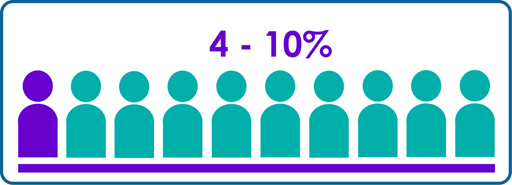2.7. Breaking the myths
Dyslexia is often misunderstood and over the years a number of misconceptions have circulated.
Activity 4
a.
Dyslexia is all about reading and spelling difficulties
b.
The incidence of dyslexia is higher amongst males
c.
Not many people are dyslexic
d.
Only ‘clever’ people have dyslexia
e.
Dyslexia is a sign of low intelligence
f.
Dyslexia cannot be a disability
g.
Specialist support teachers are the only teachers who should provide appropriate support, planning and monitoring of dyslexic learners.
No correct answers.
Discussion
1. Myth - Dyslexia is all about reading and spelling difficulties
Fact - Dyslexia does not only impact on literacy – reading, writing and spelling. The working definition highlights the other characteristics shown below which can also impact on:
2. Myth - The incidence of dyslexia is higher amongst males
Fact - Previously it was a widely-held belief that dyslexia affects boys more than girls. This is most likely due to the differences in coping strategies employed by each gender. Current consensus supports the belief that males and females are equally affected; although this remains an area of debate.
3. Myth - Not many people are dyslexic
Fact - There is consensus that between 4 – 10% of the population are dyslexic - although not all will have a formal identification of dyslexia and this remains an area of debate. It is estimated that one person in ten is dyslexic in Scotland (approx. 550,000), with 1 in 4 of those 10 (2.5%) classed as severely dyslexic.
4. Myth - Only ‘clever’ people have dyslexia.
Fact - Dyslexia does not only occur in ‘clever’ people. Historically it was believed that dyslexia was only identifiable when the learner had a ‘
5. Myth - Dyslexia is a sign of low intelligence
Fact - As with myth 4, dyslexia is not a sign of low intelligence and does not only occur in ‘clever’ people. Historically it was believed that dyslexia was only identifiable when the learner had a ‘jagged profile’ or a noticeable gap between what they knew and could speak about compared to what they could demonstrate by reading and writing. However, consensus now holds that dyslexia exists across all ability levels. The current Scottish definition of dyslexia recognises many aspects indicative of dyslexia aside from simply language processing.
6. Myth - Dyslexia cannot be a disability
Fact – The Equality Act 2010 recognises dyslexia as a
7. Myth – Specialist support teachers are the only teachers who should provide appropriate support, planning and monitoring of dyslexic learners.
Fact −All teachers have the skills and abilities to recognise early signs of dyslexia in children at all stages, and take appropriate action in response, although they may benefit from some support to develop these skills. Pupil support begins with the class teacher; however this does not mean that class teachers are responsible for the formal identification of dyslexia. It means they play an important role in the initial stages and the continuing monitoring and assessment of learning – as they do for all their pupils. It is the responsibility of all who work with children to respond appropriately to their needs.
Recognising early signs of difficulties and adapting learning and teaching approaches are a regular part of the daily routine for teachers supporting all children in an education environment. For those who may have additional learning needs such as those arising from dyslexia, it is important that these needs are met in the best possible way by accurate and timely identification.
Further information to support literacy difficulties and dyslexia can be accessed on the Addressing Dyslexia Toolkit [Tip: hold Ctrl and click a link to open it in a new tab. (Hide tip)] and Dyslexia Scotland’s website.
If your answers were not all correct you may wish to refer back to the Scottish definition of dyslexia at the start of this section.
2.6. The impact of dyslexia

